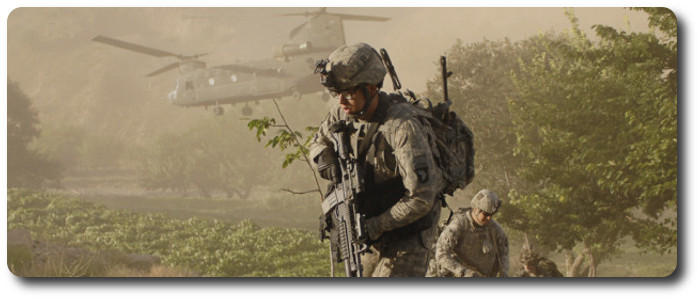
The Soldier's Load; Planning Smart (1990)
Lieutenant Colonel John S. O'Conner, Michael S. Bahrke
Infantry, Vol. 80, No. 1, Jan-Feb 1990
Editor's Note: This article is the first in a planned series of three. It offers guidance on the various factors a commander must consider when planning the operational loads their soldiers will carry. The second article will detail a physical training program that is designed to improve our soldiers' ability to carry loads on road marches. The third will provide information gained from a study that highlights the factors that are most important in determining road marching performance.
History has shown repeatedly that the burden a combat soldier carries directly affects his ability to fight and thus his chances for victory. With the addition of a significant number of "light" forces to the Army in recent years, the problem of the loads soldiers must carry in combat has received renewed attention.
Modern commanders of light infantry units must think seriously about the question of how much equipment they can require their soldiers to carry without adversely affecting their ability to fight. The solution is not a simple one; it requires critical command judgments.
Various agencies have dealt with the soldier's load issue, but they have not reached a consensus on a doctrinal answer. As in tactical decisions, load-carrying decisions depend upon the situation,
This article takes a brief look at the doctrinal approach to lightening the soldier's load and provides certain planning information that commanders must consider when determining the operational load their soldiers will carry. It also includes a number of research-based planning factors for loaded movements.
Approaches
Before its demise, the Army Development and Evaluation Agency (ADEA) spent considerable time and resources trying to find ways to reduce the soldier's load and increase his ability to carry his mission essential equipment. Those efforts resulted in five approaches:
- Lighter weight components.
- Special load-handling equipment.
- Re-evaluation of current training doctrine.
- Better soldier load-planning models.
- Special physical training programs.
The first of these, the concept of using lighter components in equipment, is as old as the Army itself. Significant progress has been made in reducing weight without detracting from function—as demonstrated in the latest versions of uniforms, equipment, and weapons—but technology is not a cureall. The primary drawbacks to the technological approach are still the prohibitive cost, poor performance capability, and inadequate length of service of such equipment. Additionally, it has been estimated that, in equipment design, only six percent of the total weight can be reduced through advanced technology and components.
The use of special load-handling equipment can increase the total amount of equipment that is moved and can help soldiers transport it forward. For example, handcars, animals, and small mechanical trucks (such as the M274 "Mule") have been used in the past with varying degrees of success to help soldiers move their equipment. In some instances, these systems are still part of the Army's tactical equipment. Unfortunately. though, in many cases such items are not suitable for use in tactical situations or deployment schemes. Further, they add more burdens to a unit in terms of training, maintenance, and support. Paradoxically, they even add to the supplies that must be moved forward.
The idea that improvements in training and doctrine can facilitate improvements in the type and amount of equipment soldiers must carry into combat is relatively new and untested. For example, this concept suggests that improved marksmanship can reduce the number of rounds of ammunition a soldier will need for a particular combat mission. Likewise, it suggests that the more judicious and timely deployment of a well-disciplined force can reduce the amount of support the soldiers will need to do their job, thus reducing the loads they must carry. Few will argue against better training and more imaginative doctrine for improving combat effectiveness, but it is uncertain that this concept will produce direct or significant savings in the amount of weight soldiers must carry into battle.
The proposal to develop better loadplanning models places the responsibility for the soldier's load directly on the leader. In order to select only the equipment his unit will need to accomplish its mission (instead of over-burdening the soldiers with the "just-in-case" provisions often directed by those who are not actually going to carry the load), a leader must gather all of the information he can about the mission, enemy, terrain, troops, and time available.
Mobility
In addition, a leader must distribute loads wisely to improve his unit's ability to sustain its mobility; this will also reduce fatigue and insure that the soldiers have the physical vigor they will need for the light.
The proposal that special physical training programs be designed to improve the individual soldier's ability to carry a load is not aimed at reducing the load itself but at improving the soldier's ability to carry it.
This is a straightforward and logical approach. Without question, a more physically fit soldier will be able to carry a heavier load, and carry it longer with less fatigue, than an unfit soldier. The most appealing aspect of this approach is that any unit can put it into practice with guaranteed results. Commanders must recognize, though, that physical training will not make up for overloading. Training soldiers to carry 80 pounds, for example, does not prepare them to carry 120 pounds when they are alerted to deploy.
All of these considerations provide a doctrinal approach to reducing the soldier's load and improving his ability to move his equipment on the battlefield. While it is important for commanders to understand the present doctrinal efforts, in reality they should concentrate their efforts on those areas in which they can exert a direct influence—the load-planning and physical training approaches.
For most commanders the question remains: What is the heaviest load a soldier can carry and still function effectively on the battlefield? Obviously, there is no single answer to that question. To make smart decisions, a commander must expand this question and ask: How far, how fast, over what terrain, and under what conditions will the soldier have to carry the load? And also, what does the soldier have to do afterwards and how soon?
With these questions in mind. Tables 1 through 3 list certain factors a commander should consider during the planning stages of those operations in which individual soldiers loads could have a definite bearing on the outcome of the mission.
The positive benefits of smart leadership cannot be overstated. As in most activities, well-led units perform better than poorly led ones during road marches with loads. Nevertheless, leaders cannot ignore the realities of physical effort. For example, an error leaders frequently make in determining the loads their soldiers will carry is to rely on their units' aggressiveness. Their rationale for this is that well-trained soldiers. when they must, can "suck it up and drive on." While it is true that soldiers can often perform above the expected levels for short periods, constantly requiring extraordinary effort from them only sets the stage for failure in the long run.
Many infantrymen accept the often-quoted 1984 Infantry School guidance of 72 pounds for approach marches and 48 pounds for combat actions as being the maximum loads soldiers should carry. Unfortunately, this all-encompassing general rule of thumb can be widely inaccurate, because it ignores the School's later guidance that a soldier's weight must also be taken into account. (See Commandant's Note, by Major General Edwin H. Burba, Jr., INFANTRY, May-June 1986, pages 2-3.)
In fact, a soldier's ability to carry a load successfully without undue fatigue is closely related to his size. For example, a 150-pound soldier who must carry a 100-pound load, or 67 percent of his body weight, expends a large amount of energy and can be expected to tire rapidly. On the other hand, a 200-pound soldier with the same 100-pound load carries only 50 percent of his body weight and expends far less energy.
The lesson for leaders is that a unit's load plan should not be based on distributing the unit's equipment equally among the soldiers, but on the soldiers' relative body size and weight. Recent research suggests that loads of 35 to 45 percent of a soldier's body weight are the most desirable for sustained non-contact movements, with 20 to 30 percent being the most realistic for combat missions. Loads should be as specific as possible for each mission.
(In determining which end of this weight range to select, leaders should also consider a soldier's physical condition. There is no absolute rule for this, however.)
Previous research on load bearing has established the fact that the rate at which a soldier expends energy will determine how long he can carry a given load. For example, a soldier carrying a 77-pound load and moving at 3.5 miles per hour will expend almost twice as much energy (550 kilocalories per hour) as one carrying 40 pounds and moving at 3.0 miles per hour (300 kilocalories per hour). Commanders must therefore consider energy expenditure in determining their soldiers' ability to sustain movement while marching with heavy loads.
In addition to the weight soldiers will carry, leaders must also consider the type of ground they will be covering and the speed at which they can be expected to move on that ground. Anything that increases the amount of energy the soldiers use will also lessen the length of time they can sustain effective movement. As one might expect, the terrain is an important factor in sustaining movement with a load. The softer (and steeper) the ground and the thicker the vegetation, the higher the energy expenditure and the sooner speed of movement declines. Marching all night and attacking all day makes for good reading, but in reality sets the stage for defeat.
After assessing these various planning considerations, smart commanders can determine the amount of equipment that will be needed for a specific operation. And once they have identified the load, they can more wisely distribute the equipment throughout the force to reserve the soldiers' energy.
Commanders who take all of these factors into consideration can formulate realistic movement plans that will give their tactical plans the greatest possibility of success.
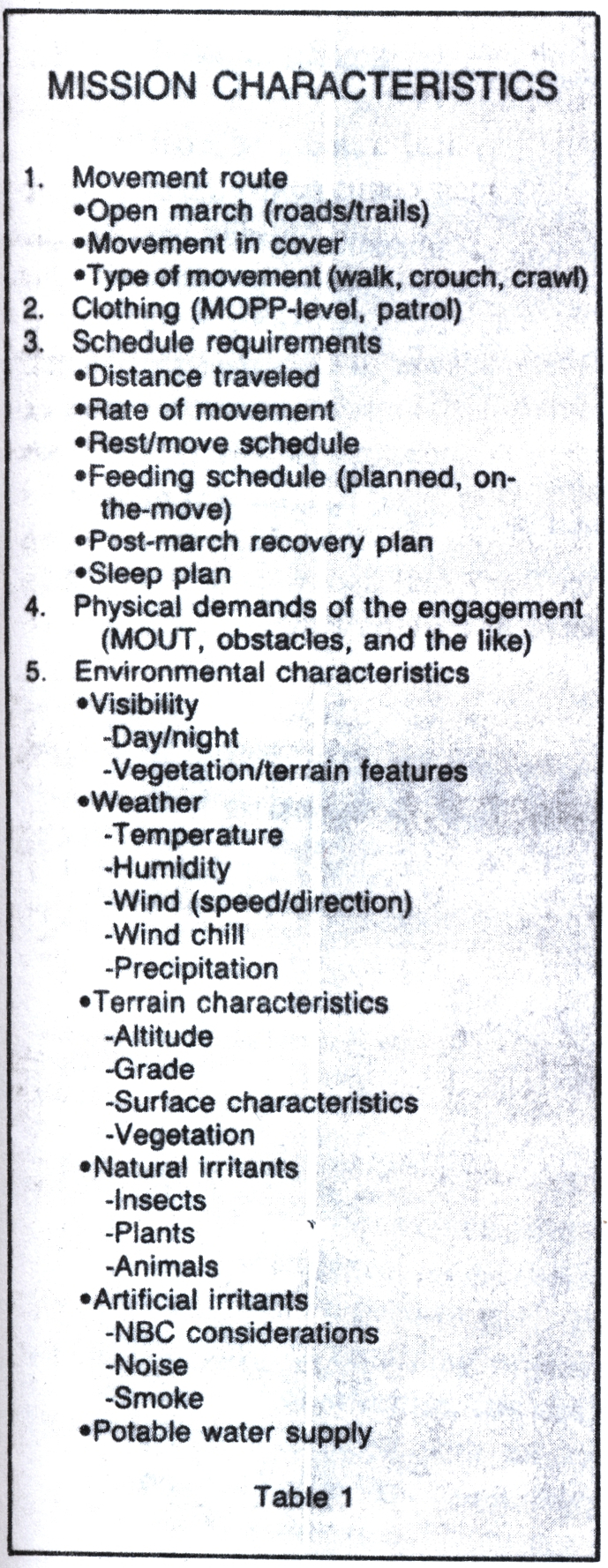
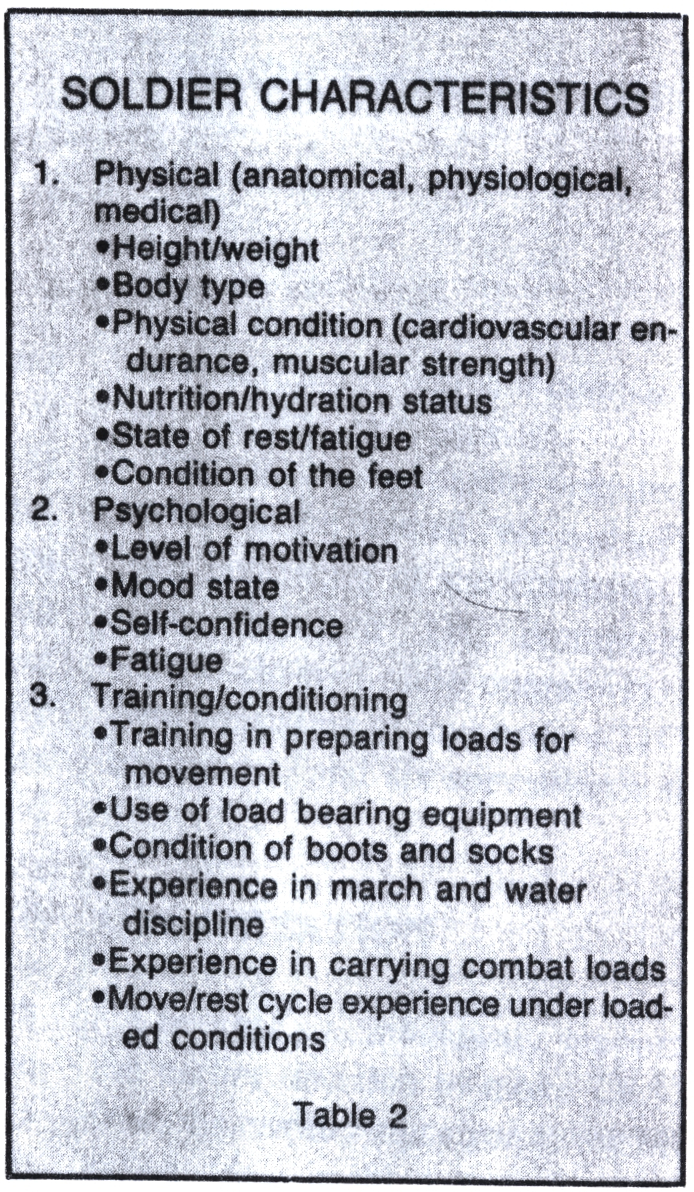
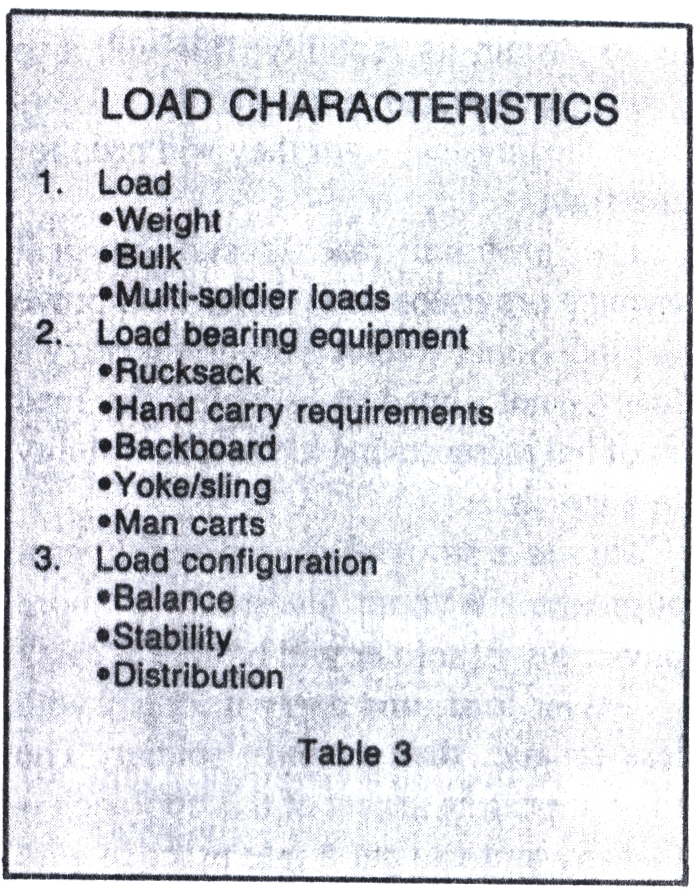

Lieutenant Colonel John S. O'Conner, an Infantry officer, is Director of Training at the US Army Physical fitness School, Fort Benjamin Harrison, Indiana. He has served in a variety of infantry units including service in Vietnam. He holds a PhD in Exercise Physiology.
Michael S. Bahrke, who also holds a PhD, is Director of Research at the Physical fitness School. He is a research psychologist with an extensive background in human factors research.
- The O'Leary Collection; Medals of The Royal Canadian Regiment.
- Researching Canadian Soldiers of the First World War
- Researching The Royal Canadian Regiment
- The RCR in the First World War
- Badges of The RCR
- The Senior Subaltern
- The Minute Book (blog)
- Rogue Papers
- Tactical Primers
- The Regimental Library
- Battle Honours
- Perpetuation of the CEF
- A Miscellany
- Quotes
- The Frontenac Times
- Site Map
QUICK LINKS
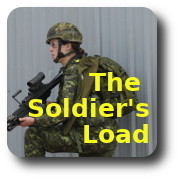
- The Service Kit of the Infantry Soldier (1901)
- The Load Carried by the Soldier (1921)
- The Equipment of the Infantry Soldier In the Light of War Experience (1923)
- The Mobility of One Man (1949)
- Keep The Doughboy Lightly Loaded (1950)
- The Soldier's Load (1955)
- The Accoutrements of the British Infantryman, 1640 To 1940
- A Soldier's Load (1987)
- The Soldier's Load; Planning Smart (1990)
- Soldier Load; When Technology Fails (1987)
- Load Carrying Ability (1990)
- Roadmarching and Performance (1990)
Soldier's Load posts on The Minute Book (blog)
- Soldiers Load (Canadian Militia, 1870)
- The Soldier's Load — The RCR at Vimy Ridge
- FSPB 1914 — Dismounted Soldiers
- Germany 1900-1914
- The Lewis Gun Section (1925)
- Platoon Weapons and Ammunition (1942)
- A historic problem
- The Soldier's Load (1871)
- A Soldier's Load
- The Infantry Platoon; 1942
- Dress and Equipment (1918)
- Soldier's Load; North Africa
- The Soldier's Load; Vietnam
- Factors Causing Soldiers' Overload
- The Soldiers Load; Australia
- The Soldier's Load in Vietnam
- Soldiers' Load — US Army — 1916
- Burden Put on Doughboy
- Sending Men to Death by Overloading
- To Test New Equipment (US Army, 1911)
- Exhaustible Infantry
- What a Soldier Carries
- The Burden the Soldier Boy Carries (1918)
- Japanese Soldier's Load (1910)
- Heaviest Laden Pack Animal in American Army
- Soldier's Kit in South Africa
- [US] Army Tries to Reduce Pack Weight (1963)
- The Soldier's Kit (1932)
- With a 70-Pound Pack (US Army, 1925)
- The Soldier's Load, Canadian Militia (1868)
- Commando Arms and Equipment